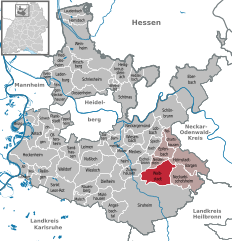Waibstadt
You can help expand this article with text translated from the corresponding article in German. (February 2009) Click [show] for important translation instructions.
|
Waibstadt | |
|---|---|
 Waibstadt at sunset | |
Location of Waibstadt within Rhein-Neckar-Kreis district  | |
| Coordinates: 49°17′51″N 08°55′12″E / 49.29750°N 8.92000°E | |
| Country | Germany |
| State | Baden-Württemberg |
| Admin. region | Karlsruhe |
| District | Rhein-Neckar-Kreis |
| Subdivisions | 3: Waibstadt (Main Town), Daisbach, Bernau |
| Government | |
| • Mayor (2017–25) | Joachim Locher[1] |
| Area | |
| • Total | 25.57 km2 (9.87 sq mi) |
| Elevation | 172 m (564 ft) |
| Population (2022-12-31)[2] | |
| • Total | 5,728 |
| • Density | 220/km2 (580/sq mi) |
| Time zone | UTC+01:00 (CET) |
| • Summer (DST) | UTC+02:00 (CEST) |
| Postal codes | 74915 |
| Dialling codes | 07263 |
| Vehicle registration | HD |
| Website | www.waibstadt.de |
Waibstadt (pronounced [ˈvaɪ̯pˌʃtat] ) is a town in the district of Rhein-Neckar-Kreis, in Baden-Württemberg, Germany.
It belongs to the municipal administration union "Waibstadt", which consists of Epfenbach, Helmstadt-Bargen, Neckarbischofsheim, Neidenstein, Reichartshausen and Waibstadt itself. Furthermore, it is part of the touristic region Brunnenregion.
Geography
Geographic location
Waibstadt is located in the valley of the Schwarzbach in the northern Kraichgau, about 25 km southeast of Heidelberg and about 6 km north of Sinsheim.
Neighbour municipalities
The town is surrounded in the northwest by Neidenstein, in the north by Epfenbach, in the northeast by Helmstadt-Bargen, in the east by Neckarbischofsheim, in the south by Sinsheim and in the west by Zuzenhausen and Eschelbronn.
Parts of town
Besides the main town Waibstadt, the two villages Daisbach and Bernau are part of Waibstadt.
History
The first documented mentioning date at 795 AD, but there are indications, that at the same place there was a Roman settlement.
References
- ^ Aktuelle Wahlergebnisse, Staatsanzeiger, accessed 14 September 2021.
- ^ "Bevölkerung nach Nationalität und Geschlecht am 31. Dezember 2022" [Population by nationality and sex as of December 31, 2022] (CSV) (in German). Statistisches Landesamt Baden-Württemberg. June 2023.




